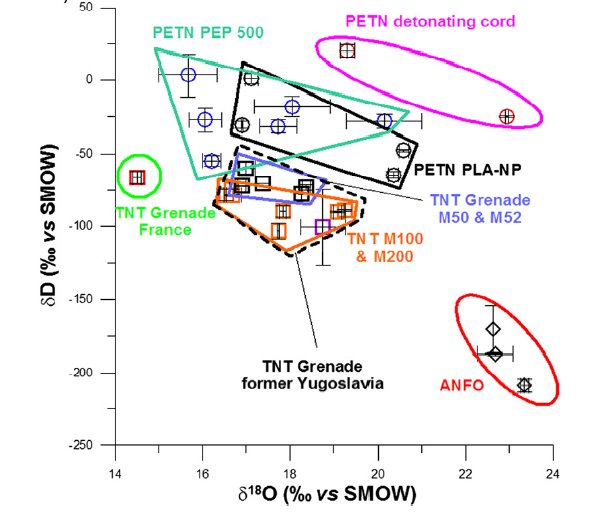PETN in the research laboratory
03 January 2010 - CSI Detroit
 And speaking of PETN, (see previous blog) a quick trip around the world for the latest on detection and forensics PETN research. First up is Mayhew et al. (DOI) who showcase a novel proton transfer reaction Time-of-flight mass spectrometer manufactured by Austrian company Ionicon (website). The detection of a range of explosives from the headspace of the room temperature solids was demonstrated despite their very low vapour pressure, for example that of PETN is stated as 3.8x10-6 Torr.
And speaking of PETN, (see previous blog) a quick trip around the world for the latest on detection and forensics PETN research. First up is Mayhew et al. (DOI) who showcase a novel proton transfer reaction Time-of-flight mass spectrometer manufactured by Austrian company Ionicon (website). The detection of a range of explosives from the headspace of the room temperature solids was demonstrated despite their very low vapour pressure, for example that of PETN is stated as 3.8x10-6 Torr.
This particular detector is as big as a freezer but the next one can fit in a shoe. Babis et al. (DOI) in collaboration with Sandia National Laboratories have built a hand-held ion mobility spectrometer (IMS) for explosives detection. In ISM a molecule is (usually radioactively) ionized and then forced to travel through a so-called drift tube with an applied electric field and an opposing carrier gas. The ions mass, shape and charge then determine how long it will take to reach the end of the tube. One would expect to find one peak in the ion mobility spectrum for each type of explosive but for some unexplained reason PETN has multiple peaks that should complicate analysis. In any case the vapor concentration of PETN at the detection limit was found to be 180 ppb.
No money to buy all this expensive equipment or does your country suffer from certain trade sanctions? Chaloosi et al. from the Iranian Tarbiat Moallem University report on a poor-man PETN detection system based on humble TLC (DOI). Well, the technique used was the more advanced high performance Thin layer chromatography and spot detection was aided by a densitometer all of which made it possible to determine a PETN detection limit of 0.180 microgram per spot.
More news from the forensics department. Ordinary gas chromatography was used for the detection of PETN by Oxley et al. of University of Rhode Island who in a recent study (DOI) examined traces of it on hair samples from students doing explosives field training at Fort A.P. Hill. 80% of these students tested positive on average with those with black hair among 7 different colors taking the lead (there is no limit to the amount of things you can test!).
And finally two studies from the journal Science and Justice on isotope analysis relating the isotopic signature if a PETN sample to the original manufacturing site. In French research Widory et al. (DOI) combined isotope ratio mass spectrometry and elemental analysis to discriminate between different PETN manufacturers and even went as far to analyse how isotopic signatures vary over time (and now for my next experiment I will be needing Yugoslavian TNT from the 1960's, the 1980's and 1990's!). In Australian research Benson et al. (DOI) carbon and nitrogen isotope values were used to identify PETN from various sources. Wikipedia is vague on the origin of geographic distribution of isotopes. It only explains how heavy oxygen is being depleted with latitude due to weather pattern but what about carbon or nitrogen?
